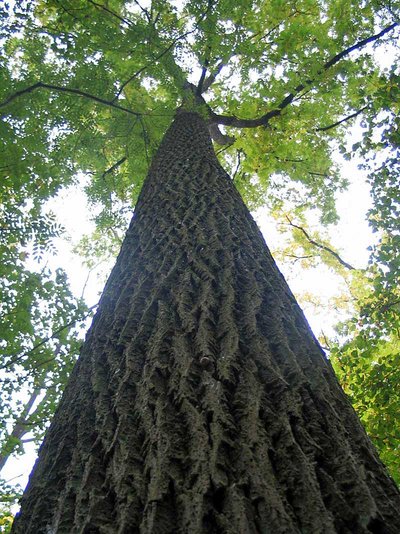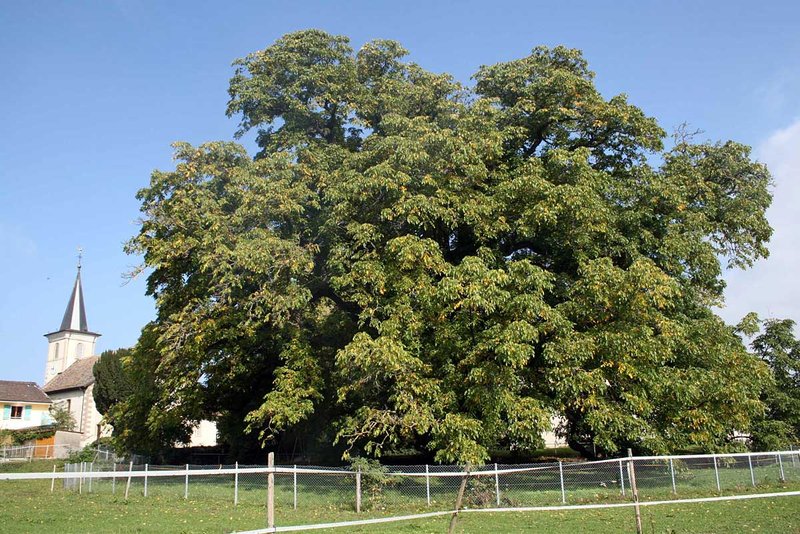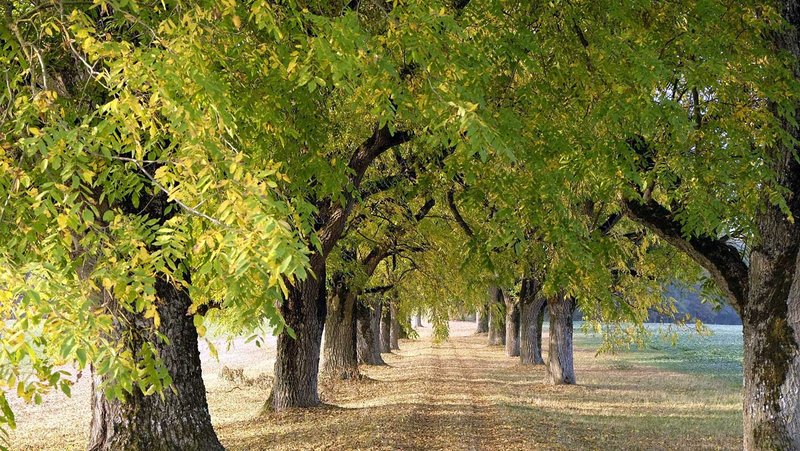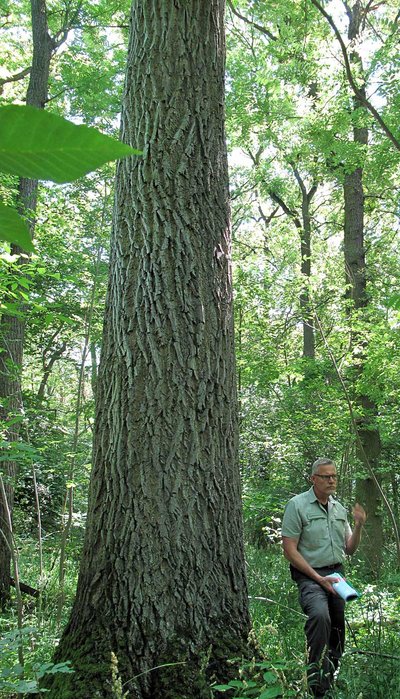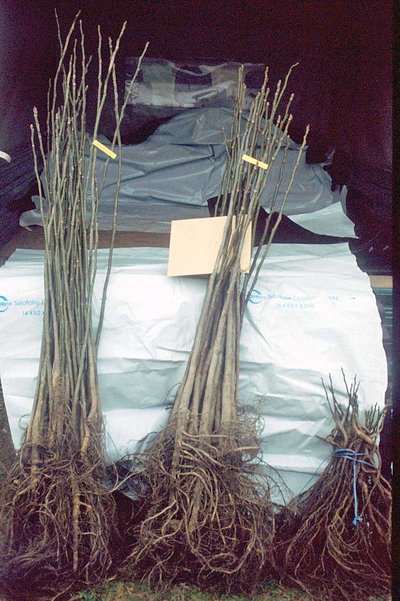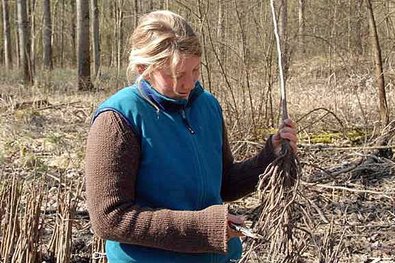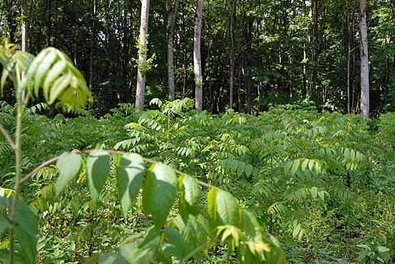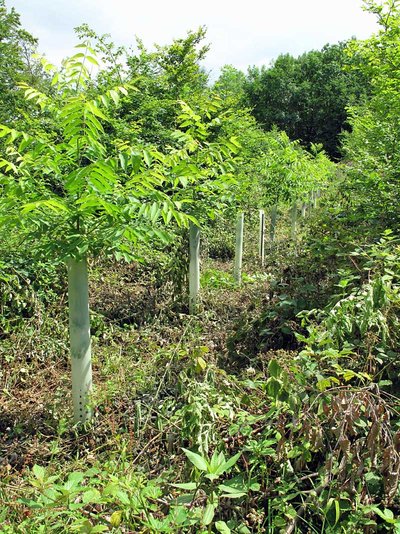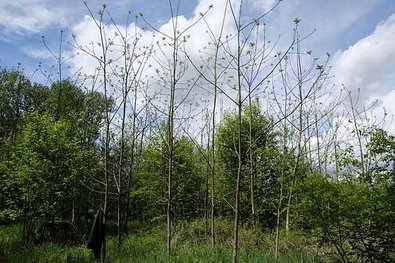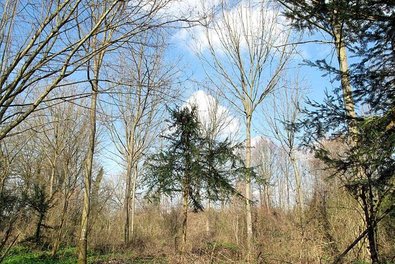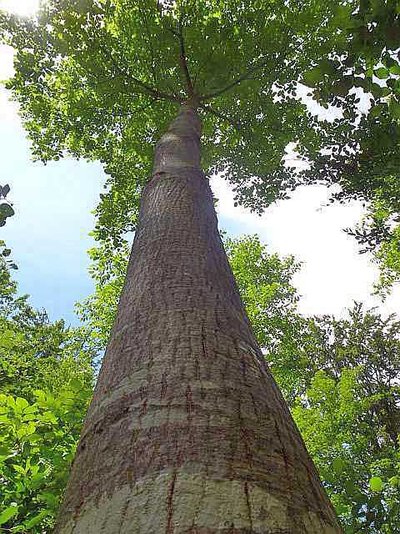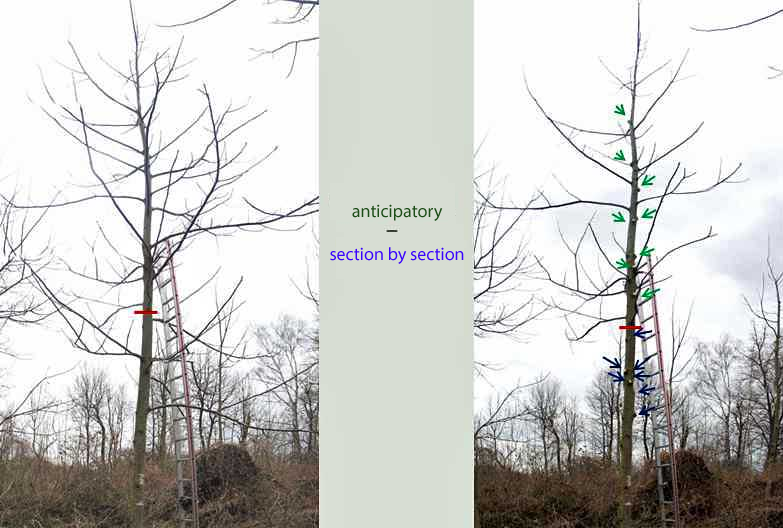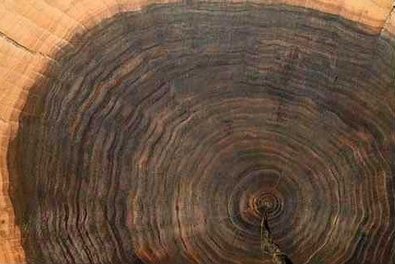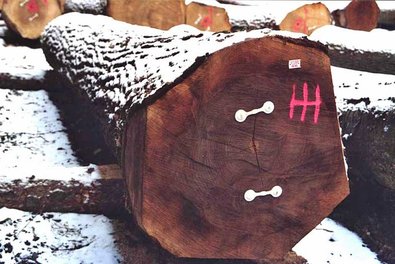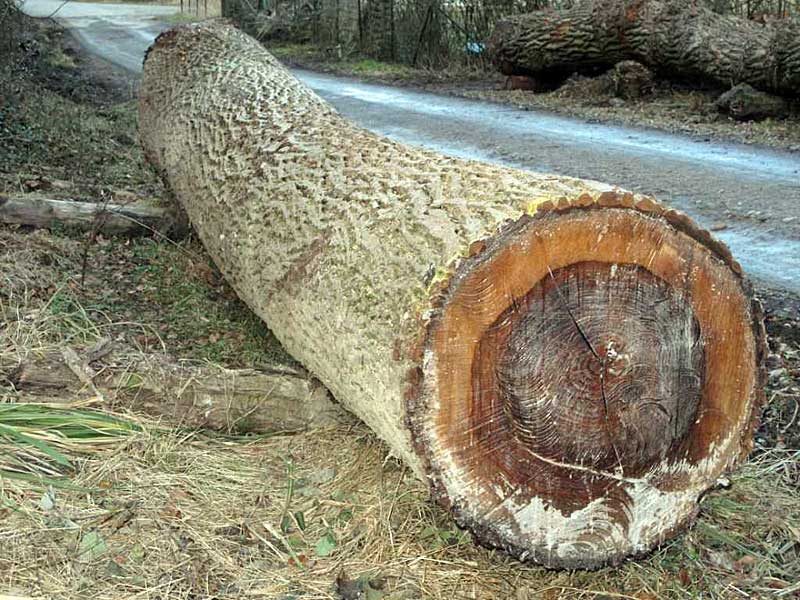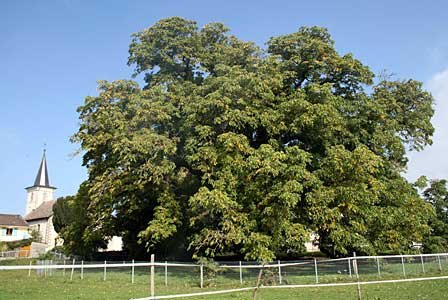Natural distribution
Eastern American black walnut (Juglans nigra L.)
The black walnut is native to eastern North America, where it has a large distribution area with considerable climatic differences, and where it has developed various adapted ecological varieties. It is common in mixed forests up to about 1200 m above sea level, mainly in association with the white ash Fraxinus americana and the tulip tree Liriodendron tulipera. It grows best on the floodplains of the River Ohio and in the Mississippi lowlands. In these areas it can reach heights of up to 45 metres. One author suggests an average annual temperature of 13 °C, at least 170 frost-free days, and an average annual precipitation of at least 890 mm as the optimum conditions for the black walnut. In its home range, the black walnut is valued not only for its high-quality and valuable wood, but also for its edible seeds (nuts).
The first mention of the black walnut in Europe dates from 1629 in England. In Germany it was first referred to in Leipzig in 1686. The first forestry trials with black walnut in Europe were carried out in the riparian forests along the rivers Rhine and Danube, and particularly extensively in the Prussian state forests from 1881 onwards. In these coordinated cultivation trials with exotic tree species, which aimed to ensure a supply of valuable timber species, the black walnut was seen as a particularly promising tree species. In the Prussian state forests alone, black walnut was sown and planted on experimental areas covering a total of 64 ha between 1881 and 1884. In 1939 it was reported that the trees on only around 10% of these experimental areas had reached the age of 30. The reasons for this high rate of failure are still quite unclear. From 1882, a forester called Rebmann began to establish extensive plantations of walnut on a total of around 60 ha in the Rhine lowlands between Strasbourg and Colmar in Alsace. He became known, sometimes derisively, as the “nut man” as a result of his strong commitment to walnut plantations. However, about 85 % of these walnut plantations in Alsace failed. Today, a few black walnut stands of more than a hundred years old are to be found on the best riparian forest sites along the Rhine (Fig. 1), and otherwise in Europe mainly on the floodplains of the Danube in Hungary and Romania. The provenance of the black walnut seeds used at the time is unclear, but a large proportion of the seeds were obtained through the BOOTH nursery. At the time, around 250 individual trees in parks and botanical gardens were available to Rebmann for the harvesting of seeds for his Juglans nigra and Juglans cinerea cultivations in Alsace.
Hybrid walnut
This term covers various natural and artificial crosses within the Juglans genus. They are interesting from a silvicultural point of view, as some of the cross progeny show better growth performance in the first generation than their parents (heterosis effect). The easily growing hybrids were obviously popular in parks and large private gardens in France and French-speaking Switzerland, because that is where the oldest known hybrid walnut trees are to be found. The first mention of a hybrid walnut came from France. This was a cross between black walnut and walnut, planted in 1815 in the park of the Vilmorin family near Paris, and named Juglans vilmoriana after its owner. The dying tree had to be felled in 1996. It had a BHD of 130 cm, a height of 32 m, a total volume of 18 m³, and a trunk volume of 8 m³ with a trunk length of 6 m. The name Juglans x intermedia was only introduced later. In Meinier, near Geneva, there is a mighty, solitary 155-year-old Juglans intermedia with an extremely broad crown (Fig. 2).
Another very impressive walnut hybrid stands in the Steiner Wald forest, Lampertheim Forestry Office (Fig. 4). This approximately 115-year-old Juglans intermedia has a diameter at breast height of 120 cm and a calculated trunk volume of 12 cubic metres (standing gross volume).
The advantages of walnut hybrids for forestry cultivation were first recognised in France, and thanks to intensive cooperation between forestry researchers, nurseries and forestry practitioners, various walnut hybrids have been bred, tested and cultivated since the early 1970s. In Baden-Württemberg the first walnut hybrids in the forest were described in an unpublished thesis by a trainee forester in 1985. The author found these incidental crosses in several black walnut stands in the area managed by Breisach Forestry Office. By that time, seed orchards had already been established in France for the production of hybrid walnut seeds.
Two walnut hybrids recommended for cultivation in southern Germany and for which planting material is available commercially are presented below:
Intermedia hybrids (Juglans nigra x Juglans regia); the commercial varieties, available from France, are NG 23 and NG 38. NG stands for Juglans nigra. Black walnut trees were selected for their quality, growth performance and especially their flowering time, and numbered. Seed orchards were established from these individual trees by taking scion cuttings and grafting. The trees are usually pollinated by the FRANQUETTE walnut (Juglans regia) cultivar. The German commercial variety RENI is a protected variety produced by the Schott specialist walnut nursery in the Kaiserstuhl region in south-western Germany. RENI stands for Juglans regia and Juglans nigra. The selection of the trees and establishment of the seed orchard was broadly similar to the procedure in France. The mother tree of these intermedia hybrids is Juglans nigra, and the father tree is Juglans regia. All plants available to date are seedlings from seed orchards. The company is working on the micropropagation of the commercial variety RENI, and the first plants were planted out in 2018. In southern Germany, the Intermedia hybrids are the preferred choice for planting, and recommended. The Intermedia hybrid has become known in southern Germany as “Intermedia”, and this word is now generally used in the German language as a synonym for hybrid walnut. The parent species do not hybridise too well with each other, so the progeny are available only in small quantities. In rare cases, incidental crosses of the Intermedia hybrids may occur in black walnut stands (Fig. 4).
Garavel hybrids (Juglans major x Juglans regia); the commercial variety, available from France, is MJ 209. This hybrid is widespread in France and the hybrid walnut most often cultivated there, as the parents hybridise easily and the plants are available in sufficient quantities. In vitro propagation is possible (Fig. 5). The Garavel hybrid develops leaves somewhat later in spring in Germany than in France and is therefore less vulnerable to late frost.
Site requirements
Both black walnut and hybrid walnut require deep, well-aerated soils rich in nutrients and with pH values between 5 and 8. Free excess lime is not a limiting factor, but black walnut trees are less tolerant of free excess lime than the walnut Juglans regia. The black walnut is the most demanding in terms of its water supply requirements. The hybrid walnut can be cultivated in all areas down to the “moderately dry” category, albeit with a marked decrease in growth performance. Compacted and extreme alternately wet and alternately dry sites are just as unsuitable as sites with clay or gravel layers in the subsoil that are impenetrable for the walnut roots, as well as sites with very high groundwater levels. The average annual mean temperature should be at least 8 °C.
In its original homeland, the black walnut has a wide distribution area with extreme climatic differences. It grows best on lower slopes and in river valleys, in moist and fertile soils with an almost neutral pH. The soils are usually sandy loams or loam with alluvial sand. The roots must be able to penetrate to a depth of at least 0.8 m. In Germany, the black walnut shows the best growth on floodplains and in valleys with access to the groundwater, but it also thrives on deep, well-drained loam soils. It tolerates short-term flooding. The many unsuccessful attempts to cultivate the black walnut around 1900 can presumably also be attributed to the selection of unsuitable sites.
The hybrid walnut is suitable for all sites that provide the conditions described above as necessary for walnut trees. The hybrid walnut thrives on a significantly larger range of sites than the black walnut. It is not as demanding as the black walnut when it comes to its water supply, but does of course grow more slowly in difficult conditions. In the district of Ludwigsburg, great success has been reported with hybrid walnuts up to 20 years old on sites that are very well supplied with nutrients, but less suitable for black walnut because of the water supply. Some members of IG NUSS, a [German] interest group for the promotion of the cultivation of walnut trees, are agreed that “the (still young) walnut trees were the ones that survived the drought year of 2018 best” in their forest.
Cultivation risks
Eastern American black walnut
This species tolerates low winter temperatures (down to around -40 °C) without suffering damage – if we consider the climatic site spectrum of the black walnut in its area of origin. The black walnut is vulnerable to late frost, which can lead to deformation in young trees. The risk of fungal and bacterial infestation is low. Some authors report that this species is quite vulnerable to wind breakage, especially during summer thunderstorms and in locations directly exposed to the wind, such as the site SNu 340 near Neuburg an der Donau. Experiences made during the first attempts to cultivate the black walnut in Germany and Alsace show that a poor choice of site seems to be the greatest threat.
Hybrid walnut
Hybrid walnut tree species tolerate winter temperatures down to about -30 °C without suffering damage. They are less vulnerable to late frost than the black walnut (they bud later), but may nevertheless become stunted or deformed after a late frost. The “Garavel hybrid”, commercial variety MJ 209, requires a long vegetation period. The Garavel hybrid produces leaves somewhat later in spring than the Intermedia hybrids and is therefore less vulnerable to late frost. Its foliage and annual shoots do however remain green for a relatively long time, so that an early frost in autumn could damage the still green foliage and annual shoots. In fact, however, there are no known cases of this happening here so far. The risk of fungal and bacterial infestation is low. The risk of wind breakage is estimated to be lower than for black walnut, although it has been observed on several occasions that excessive pruning has resulted in the formation of very long vertical shoots, which have then been bent over or even broken during high winds and thunderstorms. Because of its outstanding growth as a young tree, its tending is often neglected in practice. As a decidedly light-demanding tree species, the hybrid walnut is extremely phototropic. This can lead to deformation even when just slightly overshadowed or facing competition from the side.
TCD Thousand Cankers Disease
In the mid-1990s, it was observed that black walnut trees were dying in Logan, Utah, USA. The dieback could not be attributed to any known cause. A bark beetle species (Pityophthorus juglandis Blackman) was detected on the dying trees. Later, as a result of the beetle infestation, a highly pathogenic fungal species (Geosmithia morbidia) was detected, which caused the infested trees to die within about two years. In 2013, Thousand Cankers Disease was detected on a dying black walnut north of Padua, Italy, probably introduced with timber imports from the USA. Since walnut cultivation plays an important role in this region and the disease also occurs in the common walnut Juglans regia, action was obviously taken quite quickly, and the spread of the disease was successfully prevented. It is supposed that the disease can also occur in walnut hybrids. The disease has not yet been detected in Germany.
Walnut fruit fly (Rhagoletis completa)
The walnut fruit fly that has been appearing for several years now causes huge damage for walnut farmers. The nuts of the black walnut and hybrid walnut can also be infested. The nut kernel is insufficiently nourished as a result of the infestation and loses quality. Since black walnut fruits are not harvested for oil production or any other uses in Germany, the damage here is considered relatively minor. It is conceivable however that the capacity of the nut to germinate could be impaired.
Recommendations for forestry cultivation
Choice of provenance
Walnut trees are not subject to the [German] Law on Forest Reproductive Material.
Eastern American black walnut
As the origins of the black walnuts cultivated in Germany and Alsace are largely unknown and there are several ecological breeds in the area of origin, there is uncertainty as to whether plants of the most suitable provenances have been cultivated. On the other hand, the established stands along the Rhine (e.g. Breisach, Rastatt, Karlsruhe, Philippsburg, Strasbourg, Colmar, Bellheim, Bensheim, Lampertheim) show good growth performance and produce high-quality and valuable wood, so that it is recommended that they should continue to be cultivated in southern Germany. The German Control Association for Forest Seeds and Seedlings (DKV) has for example designated black walnut stands in the Steiner Wald forest and on the Kühkopf-Knoblochsaue floodplains in Hessen as areas of special provenance.
Hybrid walnut
As well as the question of whether or not to introduce them, with the walnut hybrids, the question arises as to whether there are appreciable differences between the various commercial varieties available and whether these are significant for the purposes of forestry cultivation. From 2001 to 2005, the Forest Research Institute of Baden-Württemberg (FVA BW) organised deliveries of hybrid walnut plants from the Payre nursery south of Grenoble in France for all forms of forest ownership in Baden-Württemberg. A total of more than 31,000 hybrid walnut plants of the commercial varieties NG 23, NG 38 and MJ 209 were delivered and planted in Baden-Württemberg. In 2010, some of the areas were surveyed and evaluated as part of a dissertation for a Bachelor’s degree. The results were very positive overall. The commercial varieties NG 23 and NG 38 were particularly recommended. The MJ 209 variety had a loss rate of 23 %, which was roughly double the rate of losses of NG 23 and NG 38.
The German commercial variety RENI was not included in this study. In 2011, a comparative cultivation was established with all available commercial varieties, near Müllheim (south of Freiburg), on moderately fresh stratified loam, with moderately fresh marlstone clay on about 30 % of the area. For each commercial variety, 90 plants were planted. The varieties were planted in rows 8 m apart, with a distance between trees in the row of 2.5 m. No losses were recorded for any of the commercial varieties. RENI and NG 38 have the best height growth performance up to the age of 7, followed by NG 23 and MJ 209. A final assessment is too early at this stage. Based on experience to date, the Intermedia hybrids seem to be somewhat more vigorous than the Garavel hybrid (MJ 209) in Baden-Württemberg. As the Intermedia hybrids are not always available in the desired numbers, it might however be advisable to fall back on the Garavel hybrid, which is available in sufficient numbers.
Planting
The planting of one-year-old walnut trees is recommended. The planting method should be chosen bearing the root length of the walnut trees in mind (approx. 50 cm!). It is possible to plant using a spade, planting auger or small excavator. Overly long lateral roots and damaged root parts should be trimmed with sharp secateurs (Fig. 6).
Hybrid walnut cultures are not typical forestry cultures! They are characterised by the fact that just a few plants are planted, protected, tended and promoted. Plant numbers of 100 to a max. 250 per ha are recommended. This corresponds to planting patterns of e.g. 14 x 7 m to 10 x 4 m spacing. The plants are relatively expensive (4-7 € per plant), mature homogeneously, and are competitive. A lower number plants per ha may also be planted out to supplement natural deciduous hardwood regeneration.
For black walnut, it is recommended for cost and tending reasons that low plant numbers are planted in widely spaced row patterns, for example plant numbers of 250 to max. 1000 per ha with planting patterns of, for example, 10 x 4 m to 5 x 2 m spacing. Baden-Württemberg’s “State Guidelines for Forest Development Types” (“Landesweiter Waldentwicklungstypen Baden-Württemberg”) (2014) generally suggest planting patterns of 3 x 1 to 3 x 1.5 m spacing (Fig. 7).
When afforesting agricultural land for the first time, “quality drivers” such as willows (possibly as cuttings) or other tree and shrub species can be planted to reduce the branch growth of the walnuts. In American plantations, square planting patterns of 3 x 3 m spacing are preferred.
Natural regeneration
The black walnut regenerates well naturally. It is advisable to actively promote good quality and vigorous plants, and to include them in the subsequent stand. The hybrid walnut also regenerates naturally, although the hybrid walnut trees bear hardly any fruit. As the F2 generation, the progeny are genetically split, so that as a rule, only a very small proportion have the same favourable growth characteristics as the parent trees. Theoretically, individual offspring can also show better growth performance than the parent trees.
Seed
Given the root injuries that can be sustained during planting, sowing is a good alternative. In the case of the black walnut, proven stands can be harvested or seed from proven stands can be purchased. For the reasons mentioned above, seed from hybrid walnut trees is not recommended. Establishing a culture through sowing requires intensive preparation, and tending in subsequent years, so that the assumed savings may ultimately turn out to be the opposite. The risks of sowing are high. In the case of walnut species in particular, wild boar, mice, snails, crows and frost can lead to the loss of all plants. In some representative forest offices known for black walnut, such as Lampertheim, sowing is the preferred method for black walnut regeneration. As well as having the seeds available, these forestry offices have a wealth of experience and the will to provide intensive tending measures for the cultivation. The resulting black walnut stands are impressive!
Safeguarding the culture
As the risk to the walnut species from browsing is low, there is no need for protective fences. Protection may however be necessary in individual cases to prevent damage caused by antler rubbing. Experiences with tree tubes vary considerably, probably because of the lack of ventilation in some cases. In practice, tree tubes are often used, because they make the plants easy to find, and offer a degree of protection when the area around each tree is mown. Only well ventilated tree tubes should be used (Fig. 8).
Especially in afforestation areas, competition from grass can lead to a severe reduction in tree growth. A circle around the tree with a diameter of a good 1 m should thus be kept free of dense grass. The adding of a few shade-tolerant tree species such as hornbeam or lime can also help to inhibit grass growth by providing shade and early closure of the tree canopy. It is also recommended that forked trees are pruned in the first few years. If forking or bushes of shoots develop (often the case after late frost), the strongest shoot should be selected and others removed with secateurs. This intervention should take place as early as possible in the vegetation period and as long as the wood is green, to ensure that the remaining leading shoot is promoted. The best time to do it is in June.
Stand tending
The goal in forest walnut cultivation should be to produce strong-diameter and knot-free walnut timber in the shortest possible time. There are two possible models for dealing with broadleaved trees:
The two-phase tending model is by and large the classic model used for dealing with broadleaved timber, especially oak. “Tending phase 1: the promotion of the natural dieback of small branches” starts with the establishment of the culture or natural regeneration with a large number of young plants close together. The high number of stems is maintained. Intervention is at most only on a very small scale to regulate the proportions of tree species in mixed stands and to cautiously promote trees with a high potential. The aim is to promote the natural dieback of lower branches through tight closure of the canopy. “Tending phase 2: the promotion of the diameter growth of the plus trees" begins when the branch-free section of the trunk has reached a desired length. For walnut trees, the target is 7 to 10 m of branch-free trunk, reached with predominant tree heights of 15 to 20 m. At this point the canopy is opened up to give plenty of light to the selected plus trees in order to promote their crown development. In the past, this second phase has often not been consistently implemented. The result is stands with high-quality broadleaved timber of small diameter.
The single-phase tending model, on the other hand, allows early development of the crown of fast-growing deciduous trees. The quality of the timber is ensured by live pruning. (Baden-Württemberg’s “State Guidelines for Forest Development Types 2014”). Significantly fewer plants are sufficient in the cultivation phase with this model than with the two-phase tending model. With the trees planted in wide row patterns or clusters (Fig. 9), not only is the number of plants significantly reduced, but also the amount of tending required.
deally, natural branch dieback can be expected when the trees are planted in a cluster. However, practical experience with oak has shown that, as a rule, quality assurance through live pruning is necessary. When a predominant height of approx. 8 m is reached, the plus trees are promoted by simultaneously opening the canopy and live pruning. This tending model allows a desired target diameter to be achieved as quickly as possible, depending on the respective site. Within 15 to 20 years of planting, the plus trees will have branch-free trunks up to about 7 m, and they should then be left to mature to the desired target diameter (Fig. 10).
Pruning
The question of when is the right time for pruning has been a subject of heated debate within the IG Nuss interest group, particularly in the case of walnut trees, with some even of the opinion that walnuts should not be pruned at all, as they can bleed to death from the sap they lose after pruning. One important hint was added to this discussion by an American colleague who, when asked when walnut trees were pruned in the USA, answered dryly: “when you have time”. In a trial carried out in 1996 and 1997 to study live pruning of the walnut at different times of the year, the walnut trees were pruned in February, June, August and November. Once the wounds had completely overgrown again, the growth performance values and branch samples of the pruned walnut trees were compared with walnut trees that had not been pruned. The results showed that live pruning of walnuts in February, June and August does not lead to problems.
After pruning in November, a wood-destroying fungus was found on a branch sample, so this time of year is not recommended for pruning. In practice, late winter dates for pruning - from February until budding starts - have proven their worth. During this period, especially in the floodplains, the areas are easy to see and walk on. It is possible that sap will “bleed” during this period. This is a natural reaction of the tree that prevents fungi and bacteria from penetrating into it. The flow of sap dries up again after a few days. None of the pruned walnut trees have bled to death; many have developed into wonderful trees (See Fig. 11). The other period in which pruning has been shown to work well is the summer period from June to August. Here it is a good idea to combine tending and pruning. The tending measures make the stand more accessible and give a clearer overview, and the various physically demanding tasks to be completed can be alternated over the course of the day.
Another contentious subject of debate was the thickness of the branches to be removed. In a figurative sense, the debate over the right time to prune the branches continued so long that the branches to be removed ended up being significantly thicker than the 3 cm diameter recommended in the specialist literature at the time. This crucial question is not only important for dealing with the walnut trees. It is also important for the follow-up treatment of stands planted following storm damage, which often have unsatisfactory qualities of oak and other broadleaved trees. For this reason, an extensive trial was set up in 2003 to study the live pruning of deciduous trees. The aim was to investigate the formation of water sprouts, discolouration, decay, growth reaction and the time taken to grow over wounds in oak, beech, ash and sycamore maple as a function of branch thickness and the date of pruning. It was specified that all pruning be carried out exactly according to the findings of SHIGO (1989). The result was impressive: As long as the correct pruning technique is used, the thickness of the removed branches is of secondary importance. The recommended thickness of the branches for removal was from 4 cm to a maximum of 6 cm. This does not mean that thicker branches cannot also be cut, but that the removal of thicker branches leads to a longer period before the tree heals over the wound, an increased risk of wood discolouration, and a thinner sheath of knot-free wood. In addition, the physical effort required for pruning increases enormously and the quality of the cut suffers as a result.
Traditionally, the branches are removed section by section, “from the bottom upwards”. Especially in the case of hybrid walnut trees, the branches in the upper part of the crown very quickly become very thick. This requires a different approach. This is why dynamic pruning, a combination of anticipatory pruning and section by section pruning, is often used in agroforestry (Fig. 12).
Before the first pruning measure begins, it is decided how long the branch-free section of the trunk should be later. The top green arrow marks the uppermost branch to be removed and thus the later branch-free shaft length. After that, we look “from top to bottom”. The thickest and particularly steeply rising branches are removed, as these branches would be too thick when it came to the next pruning measure (green arrows). Thinner and gently rising green branches are left so that not too much leaf mass is removed, and to reduce the risk of water sprouts forming. The next round of pruning is determined by how quickly the branches develop in thickness. As soon as the next branches have reached about 4 cm in diameter, the next pruning measure can be carried out using the same procedure. In addition to this, all branches (blue arrows) on the lower trunk up to a trunk diameter of 10 to 12 cm should be removed. This yields the thickest possible knot-free sheath of timber. After three to four rounds of pruning, a branch-free shaft length of about 7 m can usually be achieved.
Timber revenues and timber quality
Black walnut trunks have a unique selling point among deciduous timbers in that even small diameter timber of categories 2a/2b (20-24 cm/25-29 cm) pays well. However, we should not allow this circumstance to tempt us into producing as much timber as possible from thinning activities while neglecting to promote the final crop trees properly. High quality black walnut timber (Fig. 13) fetches high prices. The sales revenues in the years 2005 to 2010 for the districts of Karlsruhe, Rastatt and Breisgau-Hochschwarzwald are shown in Tab. 1. Top prices can be over EUR 2000/m³ (solid) (Fig. 14).
Table 1: Average revenues from black walnut in the years 2005 to 2010 in the districts of Karlsruhe, Rastatt and Breisgau-Hochschwarzwald. Timber sales were mainly by tender. The average prices include grades F (veneer), TF (partial veneer), B and C.(average grades).
Diameter class (Stkl.) | Quantity sold (m³ (solid)) | Average price (€/m³) | Price min./max. |
L5/L6 (50-69 cm) | 21 | 904 | 100/2500 |
L4 (40-49 cm) | 42 | 599 | 85/931 |
L2a-L3b (20-39 cm) | 436 | 317 | 60/1410 |
all diameter classes | 499 | 365 | - |
At the University of Freiburg in 2019, an average price of more than EUR 500/m³ across all diameter classes and quality grades was determined for black walnut timber sold by tender. Black walnut is thus one of the best paying timbers from our forests. The quantity of hybrid walnut trunk timber produced in Germany has so far been very low. Tab. 2 summarises the sales of individual logs of Intermedia hybrid walnut sold by tender in recent years in the districts of Breisgau-Hochschwarzwald and Emmendingen.
Table 2: Revenues from individual Intermedia walnut logs sold by tender in the districts of Breisgau-Hochschwarzwald and Emmendingen.
Tree species | Length (m) | Diameter (cm) | Volume (m³)* | Grade | Revenue/price (€/m³) |
Hybrid walnut | 8.0 | 41 | 1.06 | TF (partial veneer) | 467 |
Hybrid walnut | 9.5 | 64 | 2.15 | A (best of four grades excluding veneer) | 1500 |
Hybrid walnut | ? | ? | 0.98 | C (3rd of 4 grades) | 125 |
Hybrid walnut | ? | ? | 1.96 | F (veneer) | 665 |
Hybrid walnut | 6.3 | 65 | 2.09 | F (veneer) | 1,709 |
Hybrid walnut | 3.5 | 56 | 0.86 | ? | 1,473 |
Hybrid walnut | ? | BHD=63 | ? | ? | 501 |
Hybrid walnut | ? | BHD>70 | ? | ? | 678 |
Hybrid walnut | 6.2 | 52 | 1.32 | TF (partial veneer) | 917 |
* cubic metres harvested
The age of the felled trees was 50 to 65 years. While the timber revenues were being researched, it emerged that some hybrid walnut logs had been categorised differently, as the IT available did not provide for the correct categorisation. Some of the hybrid walnut logs presumably became “walnut” in the course of further processing (Fig. 15). This also shows the possible uses of these timbers. The high revenues from strength class L 4 onwards are, with the exception of the very top revenues, in the same range as the revenues for black walnut logs.
In his “Investigation of important wood properties of the black walnut hybrid (Juglans x intermedia Carr.) and the black walnut (Juglans nigra L.) from stands in the Kaiserstuhl region”, FELDMANN (1992) confirmed the good wood quality of both walnut species. We quote: “In terms of its longitudinal compressive strength, impact bending strength and BRINELL hardness, the wood of the hybrid is very similar to that of the black walnut. A lower density of the hybrids of 0.52 g/cm³ in the kiln-dried state is therefore not a disadvantage ....” Regarding the colour of the heartwood, he states: “The heartwood of the black walnut hybrids was lighter than that of the black walnut, so that in colour it is closer to walnut.” Note: The hybrid walnut specimens came from the experimental plot INu 1, which was established later.
Summary
Due to their height growth capacity, black walnut and hybrid walnut are typical forest trees and can be integrated well into mixed stands. All trials and practical experience gained up to now show that the black walnut is the most demanding in terms of its site requirements. Riparian sites with connection to the groundwater are the best sites for this species. On these sites, the black walnut stands show very good growth performance and produce valuable timber. Where the water supply of the sites is limited, hybrid walnut trees are a very good alternative. The limit for economically viable hybrid walnut cultivation is reached according to expert opinion at “moderately dry”. As the areas with young hybrid walnuts develop, more information on this should become available. On suitable sites, both of the silvicultural methods presented in this article are possible for the black walnut. Although the two-phase tending model is also possible in the case of the hybrid walnut, care should be taken to promote crown development as early as possible, especially on sites with a poor water supply. With the help of dynamic live pruning, the closed canopy phase can be skipped, the trunks grow in diameter very quickly, and the quality of the knot-free trunk wood is ensured by pruning. Taking climate change into account, it is generally recommended that the single-phase tending model is used for deciduous wood stands in order to minimise risk.

